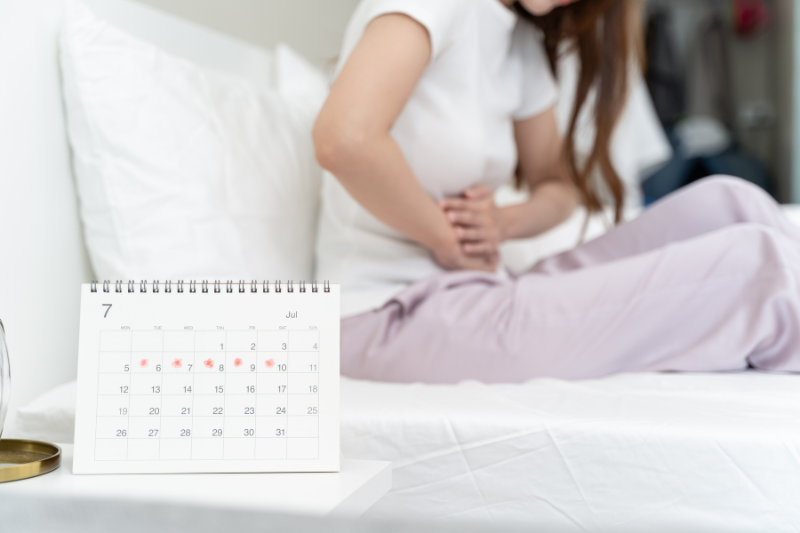- @admin123x
- 0 Comments
Menstrual cramps, medically known as dysmenorrhea, affect many women during their periods. While some experience mild discomfort, others endure severe pain that disrupts daily life. You may experience headaches, fatigue, nausea, vomiting and lightheadedness along with these cramps. Understanding the causes and exploring effective treatments can help manage this condition and improve quality of life.1,2
Primary Dysmenorrhea
Primary dysmenorrhea refers to common menstrual cramps not linked to any medical condition. It usually starts a few years after the first period and often gets better with age or after childbirth.1,2
Menstrual cramps are often caused by hormone-like chemicals called prostaglandins. These chemicals contract the uterus, and in high levels, can make cramps worse. Hormonal changes, especially in oestrogen and progesterone, can also increase cramps. Strong uterine contractions can squeeze blood vessels, reducing blood flow and oxygen, which increases pain.2
You might feel continuous pain in your lower abdomen, which can be sharp or aching. This pain can spread to your lower back and thighs.2 It’s common to feel nauseous, and you might vomit or have stomach discomfort. Dizziness, headaches and feeling very tired are also typical.2,3 Additionally, you might notice mood changes, such as feeling anxious, depressed, irritable or nervous.3
Secondary Dysmenorrhea
Secondary dysmenorrhea is caused by other health issues and usually appears later in life, growing worse over time. One cause is endometriosis, where tissue similar to the uterine lining grows outside it, leading to inflammation and severe pain. Another cause is noncancerous growths called uterine fibroids. Pelvic inflammatory disease (PID) and adenomyosis can also cause severe cramps. PID occurs when the reproductive organs get infected, and adenomyosis happens when tissue lining the uterus grows into its muscular wall. Besides these conditions, insertion of intrauterine devices can cause period pain, especially in the first few months.2
You might experience severe, persistent pain that does not go away with typical treatments. Pain during intercourse is also common. Your periods might be heavy, irregular or last longer than usual. Additionally, the pain can get worse over time or start in the middle of your cycle.2
Effective Treatments for Menstrual Cramps
You can try home remedies, lifestyle adjustments and medications to treat these cramps. However, medical interventions might be needed in severe cases.
Home Remedies
- Apply a heating pad or hot water bottle to the lower abdomen to relax uterine muscles, improve blood flow and alleviate pain.4
- Drink warm fluids, like herbal teas, to reduce bloating and soothe cramps.1,4
- Do light physical activity, such as walking or stretching, to reduce menstrual pain and improve mood.4
- Supplements like ginger and cinnamon have anti-inflammatory properties that might help with cramps.4
Lifestyle Changes
- Eat a balanced diet containing leafy greens, nuts and pumpkin seeds, which are rich in iron and magnesium, and fish and flaxseeds, which contain omega-3 fatty acids.5
- Limit salt, caffeine and alcohol intake.6
- Adequate sleep is important. Get sufficient rest to help the body recover.4
- Practice yoga with deep breathing and meditation to relax the body.7
Alternative Therapies
Alternative therapies can be helpful too. Acupuncture might ease menstrual pain by improving blood flow and releasing natural painkillers called endorphins.8
Medical Treatments
For many, over-the-counter medications can help reduce pain and inflammation. If these don’t work, prescription hormonal treatments might be an option. These can help balance hormone levels, often reducing or even eliminating menstrual cramps and making periods lighter.2,3
For severe cases or when an underlying condition is suspected, it is important to see a doctor. They can do a thorough evaluation, including pelvic exams, ultrasounds or laparoscopy, to diagnose conditions such as endometriosis or fibroids. In some cases, surgery might be necessary to remove fibroids, treat endometriosis or fix other issues causing severe cramps.2
When to Seek Medical Attention
Although mild menstrual cramps are common, there are certain symptoms that mean you should see a doctor. If you have pain that disrupts your daily activities or gets worse over time, it’s important to get checked out. Cramps that don’t respond to over-the-counter pain relievers are another sign to seek medical advice.2
Other symptoms to watch for include heavy bleeding, pain during intercourse, or irregular periods, which could indicate secondary dysmenorrhea. Additionally, if you experience unexplained weight loss, fever or severe nausea, it’s best to consult a healthcare professional.2
Conclusion
Menstrual cramps can really affect your daily life. Understanding what causes them and knowing your treatment options can help you manage the symptoms better. There are many ways to find relief, from home remedies to medical treatments. If your cramps are severe or don’t go away, it’s important to see a healthcare professional for the right diagnosis and treatment. Taking these steps can help you feel better and improve your overall well-being.
References:
- Dong Y, Li MJ, Hong YZ, Li WJ. Insight into dysmenorrhea research from 1992 to 2022: a bibliometric analysis. J Pain Res. 2023;16:3591-3611. doi:10.2147/JPR.S430233
- Nagy H, Carlson K, Khan MA. Dysmenorrhea. In: StatPearls. StatPearls Publishing; 2023.
- Itani R, Soubra L, Karout S, Rahme D, Karout L, Khojah HMJ. Primary dysmenorrhea: pathophysiology, diagnosis, and treatment updates. Korean J Fam Med. 2022;43(2):101-108. doi:10.4082/kjfm.21.0103
- Kirsch E, Rahman S, Kerolus K, et al. Dysmenorrhea, a narrative review of therapeutic options. J Pain Res. 2024;17:2657-2666.
- Nutrition and exercise throughout your menstrual cycle. Cleveland Clinic. April 4, 2023. Accessed December 16, 2024. https://health.clevelandclinic.org/nutrition-and-exercise-throughout-your-menstrual-cycle
- 11 Diet Changes That Help You Fight PMS. Cleveland Clinic. December 31, 2020. Accessed December 16, 2024. https://health.clevelandclinic.org/11-diet-changes-that-help-you-fight-pms
- Kanchibhotla D, Subramanian S, Singh D. Management of dysmenorrhea through yoga: A narrative review. Front Pain Res (Lausanne). 2023;4:1107669. doi:10.3389/fpain.2023.1107669
- Chen B, Guo Q, Zhang Q, Di Z, Zhang Q. Revealing the central mechanism of acupuncture for primary dysmenorrhea based on neuroimaging: a narrative review. Pain Res Manag. 2023;2023:8307249.

